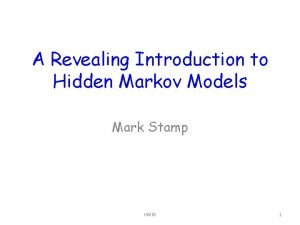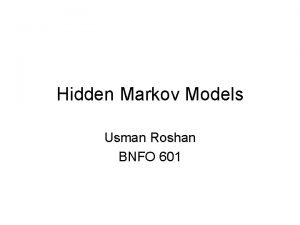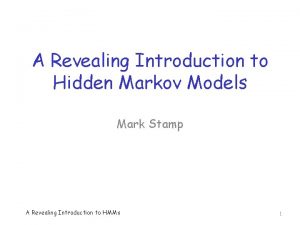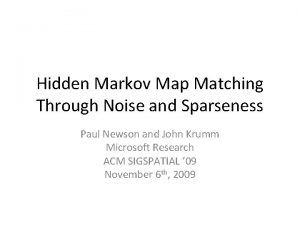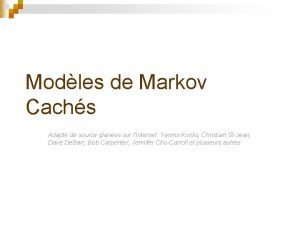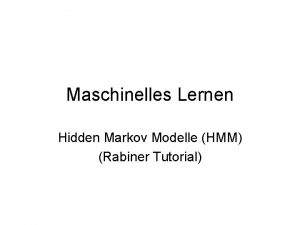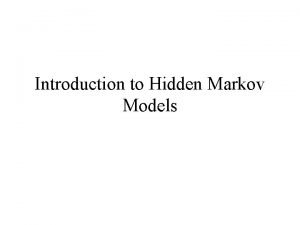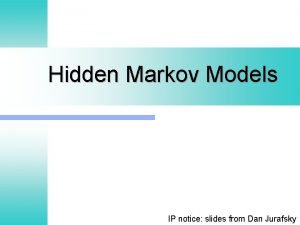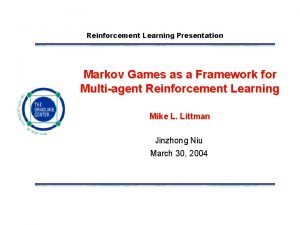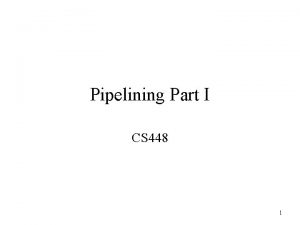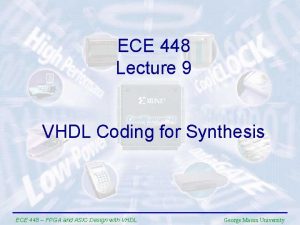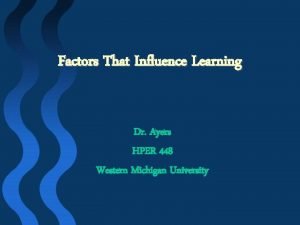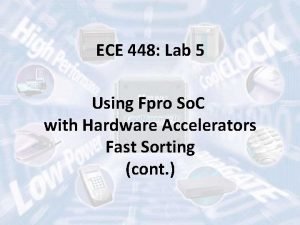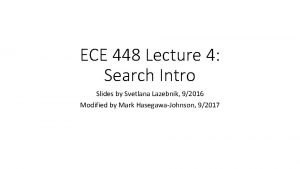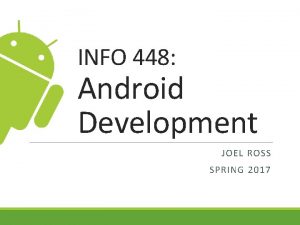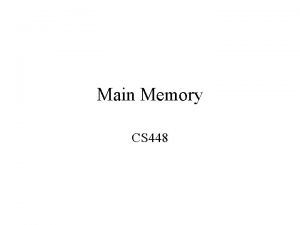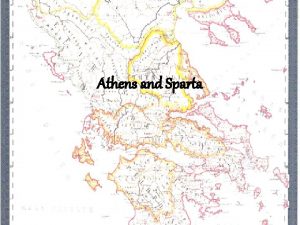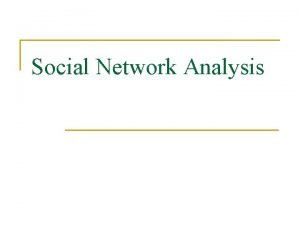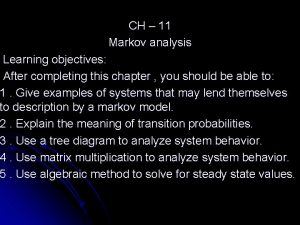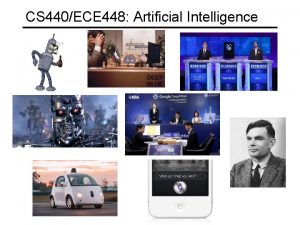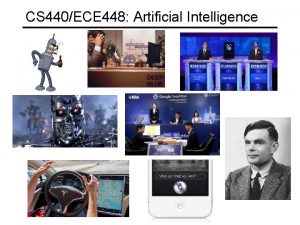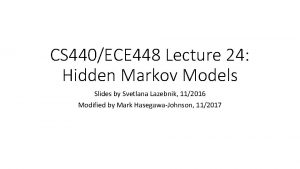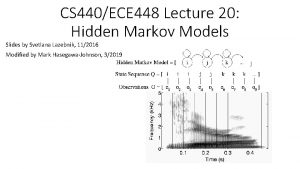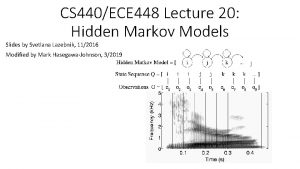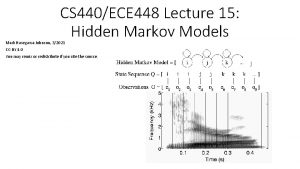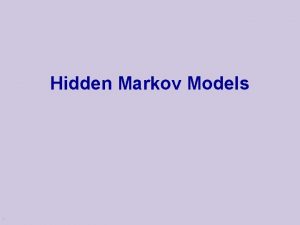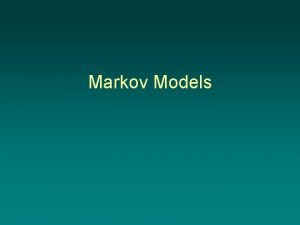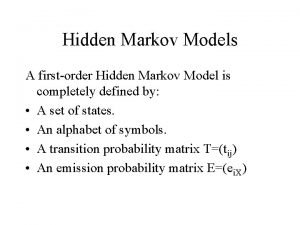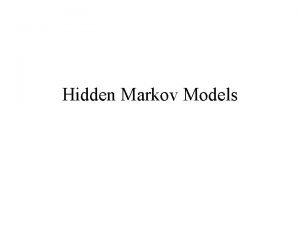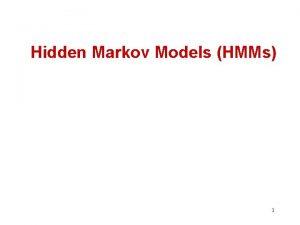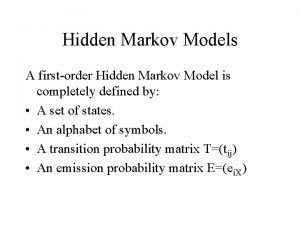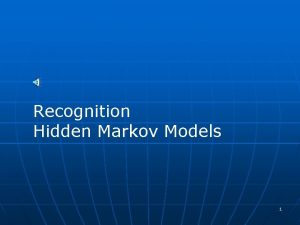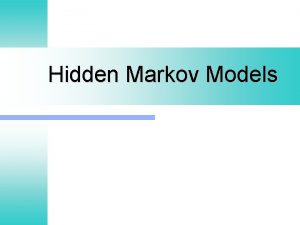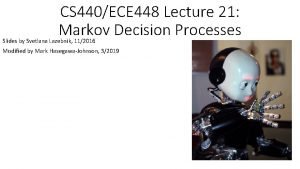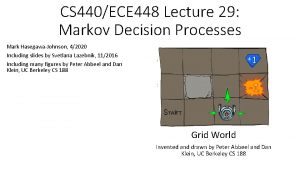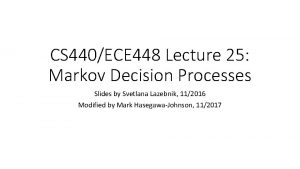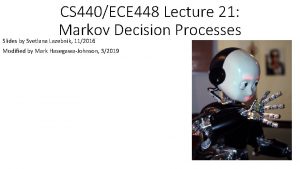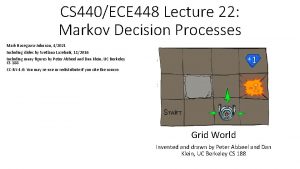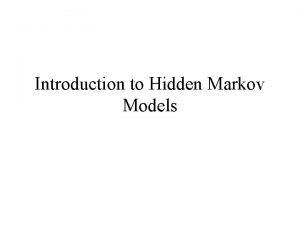CS 440ECE 448 Lecture 24 Hidden Markov Models




























- Slides: 28

CS 440/ECE 448 Lecture 24: Hidden Markov Models Slides by Svetlana Lazebnik, 11/2016 Modified by Mark Hasegawa-Johnson, 11/2017

Probabilistic reasoning over time • So far, we’ve mostly dealt with episodic environments • Exceptions: games with multiple moves, planning • In particular, the Bayesian networks we’ve seen so far describe static situations • Each random variable gets a single fixed value in a single problem instance • Now we consider the problem of describing probabilistic environments that evolve over time • Examples: robot localization, human activity detection, tracking, speech recognition, machine translation,

Hidden Markov Models • At each time slice t, the state of the world is described by an unobservable variable Xt and an observable evidence variable Et • Transition model: distribution over the current state given the whole past history: P(Xt | X 0, …, Xt-1) = P(Xt | X 0: t-1) • Observation model: P(Et | X 0: t, E 1: t-1) X 0 X 1 X 2 E 1 E 2 … Xt-1 Xt Et-1 Et

Hidden Markov Models • Markov assumption (first order) • The current state is conditionally independent of all the other states given the state in the previous time step • What does P(Xt | X 0: t-1) simplify to? P(Xt | X 0: t-1) = P(Xt | Xt-1) • Markov assumption for observations • The evidence at time t depends only on the state at time t • What does P(Et | X 0: t, E 1: t-1) simplify to? P(Et | X 0: t, E 1: t-1) = P(Et | Xt) X 0 X 1 X 2 E 1 E 2 … Xt-1 Xt Et-1 Et

Example state evidence

Example Transition model state evidence Observation model

An alternative visualization U=T: 0. 9 U=F: 0. 1 0. 3 0. 7 R=T R=F 0. 7 Transition probabilities 0. 3 Rt = T Rt = F Rt-1 = T 0. 7 0. 3 Rt-1 = F 0. 3 0. 7 U=T: 0. 2 U=F: 0. 8 Observation (emission) probabilities Ut = T Ut = F Rt = T 0. 9 0. 1 Rt = F 0. 2 0. 8

Another example • States: X = {home, office, cafe} • Observations: E = {sms, facebook, email} Slide credit: Andy White

The Joint Distribution • Transition model: P(Xt | X 0: t-1) = P(Xt | Xt-1) • Observation model: P(Et | X 0: t, E 1: t-1) = P(Et | Xt) • How do we compute the full joint P(X 0: t, E 1: t)? X 0 X 1 X 2 E 1 E 2 … Xt-1 Xt Et-1 Et

Review: Bayes net inference • Computational complexity • Special cases • Parameter learning

Review: HMMs • Transition model: P(Xt | X 0: t-1) = P(Xt | Xt-1) • Observation model: P(Et | X 0: t, E 1: t-1) = P(Et | Xt) • How do we compute the full joint P(X 0: t, E 1: t)? X 0 X 1 X 2 E 1 E 2 … Xt-1 Xt Et-1 Et

HMM inference tasks • Filtering: what is the distribution over the current state Xt given all the evidence so far, e 1: t ? • The forward algorithm Query variable X 0 X 1 E 1 … Xk … Ek Evidence variables Xt-1 Xt Et-1 Et

HMM inference tasks • Filtering: what is the distribution over the current state Xt given all the evidence so far, e 1: t ? • Smoothing: what is the distribution of some state Xk given the entire observation sequence e 1: t? • The forward-backward algorithm X 0 X 1 E 1 … Xk Ek … Xt-1 Xt Et-1 Et

HMM inference tasks • Filtering: what is the distribution over the current state Xt given all the evidence so far, e 1: t ? • Smoothing: what is the distribution of some state Xk given the entire observation sequence e 1: t? • Evaluation: compute the probability of a given observation sequence e 1: t X 0 X 1 E 1 … Xk Ek … Xt-1 Xt Et-1 Et

HMM inference tasks • Filtering: what is the distribution over the current state Xt given all the evidence so far, e 1: t • Smoothing: what is the distribution of some state Xk given the entire observation sequence e 1: t? • Evaluation: compute the probability of a given observation sequence e 1: t • Decoding: what is the most likely state sequence X 0: t given the observation sequence e 1: t? • The Viterbi algorithm X 0 X 1 E 1 … Xk Ek … Xt-1 Xt Et-1 Et

HMM Learning and Inference • Inference tasks • Filtering: what is the distribution over the current state Xt given all the evidence so far, e 1: t • Smoothing: what is the distribution of some state Xk given the entire observation sequence e 1: t? • Evaluation: compute the probability of a given observation sequence e 1: t • Decoding: what is the most likely state sequence X 0: t given the observation sequence e 1: t? • Learning • Given a training sample of sequences, learn the model parameters (transition and emission probabilities) • EM algorithm

Applications of HMMs • Speech recognition HMMs: • Observations are acoustic signals (continuous valued) • States are specific positions in specific words (so, tens of thousands) • Machine translation HMMs: • Observations are words (tens of thousands) • States are translation options • Robot tracking: • Observations are range readings (continuous) • States are positions on a map (continuous) Source: Tamara Berg

Application of HMMs: Speech recognition • “Noisy channel” model of speech

Frequency Acoustic wave form Sampled at 8 KHz, quantized to 8 -12 bits Spectrogram Frame (10 ms or 80 samples) Feature vector ~39 dim. Amplitude Speech feature extraction Time

Frequency Acoustic wave form Sampled at 8 KHz, quantized to 8 -12 bits Amplitude Speech feature extraction Spectrogram Frame (10 ms or 80 samples) Feature vector ~39 dim. Time

Phonetic model • Phones: speech sounds • Phonemes: groups of speech sounds that have a unique meaning/function in a language (e. g. , there are several different ways to pronounce “t”)

Phonetic model

HMM models for phones •

HMM models for words

Putting words together • Given a sequence of acoustic features, how do we find the corresponding word sequence?

The Viterbi Algorithm • X 0 X 1 X 2 E 1 E 2 … Xt-1 Xt Et-1 Et

Decoding with the Viterbi algorithm

For more information • CS 447: Natural Language Processing • ECE 417: Multimedia Signal Processing • ECE 594: Mathematical Models of Language • Linguistics 506: Computational Linguistics • D. Jurafsky and J. Martin, “Speech and Language Processing, ” 2 nd ed. , Prentice Hall, 2008
 A revealing introduction to hidden markov models
A revealing introduction to hidden markov models Hidden markov models
Hidden markov models A revealing introduction to hidden markov models
A revealing introduction to hidden markov models Hidden markov map matching through noise and sparseness
Hidden markov map matching through noise and sparseness Hidden markov model tutorial
Hidden markov model tutorial Hidden markov model beispiel
Hidden markov model beispiel Hidden markov chain
Hidden markov chain Hidden markov model
Hidden markov model Kpuska
Kpuska Hidden markov chain
Hidden markov chain Hidden markov model rock paper scissors
Hidden markov model rock paper scissors 01:640:244 lecture notes - lecture 15: plat, idah, farad
01:640:244 lecture notes - lecture 15: plat, idah, farad Cs 448
Cs 448 448 scmw
448 scmw Ece 448
Ece 448 Ece 448
Ece 448 Factors of 448
Factors of 448 Jest głównym dopływem wisły ma 448 km długości
Jest głównym dopływem wisły ma 448 km długości Ece448
Ece448 Ece448
Ece448 Joel ross uw
Joel ross uw Cs 448
Cs 448 Vhdl asic
Vhdl asic Ece 448
Ece 448 500-448
500-448 Modal and semi modal verbs
Modal and semi modal verbs Bing
Bing Example of markov analysis
Example of markov analysis Absorbing state
Absorbing state
